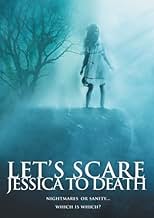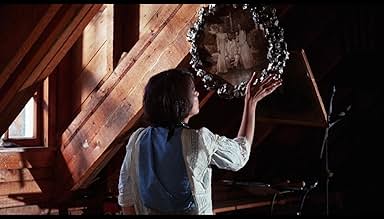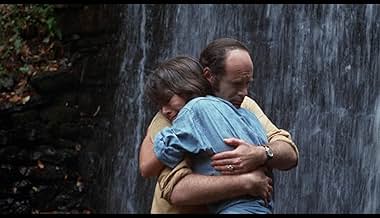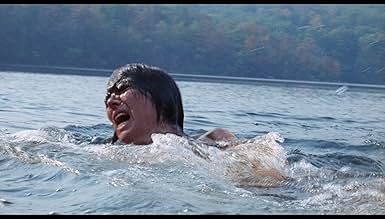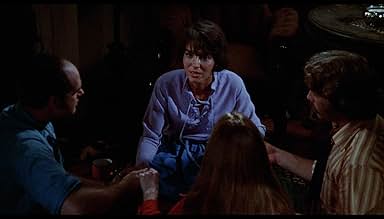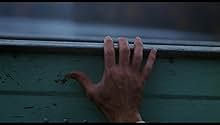AVALIAÇÃO DA IMDb
6,4/10
9,9 mil
SUA AVALIAÇÃO
Adicionar um enredo no seu idiomaA recently institutionalized woman has bizarre experiences after moving into a supposedly haunted country farmhouse and fears she may be losing her sanity once again.A recently institutionalized woman has bizarre experiences after moving into a supposedly haunted country farmhouse and fears she may be losing her sanity once again.A recently institutionalized woman has bizarre experiences after moving into a supposedly haunted country farmhouse and fears she may be losing her sanity once again.
- Direção
- Roteiristas
- Artistas
- Direção
- Roteiristas
- Elenco e equipe completos
- Produção, bilheteria e muito mais no IMDbPro
Avaliações em destaque
One of the best, CREEPIEST movies, back when they still made creepy movies WITHOUT such modern "horror movie" distractions as over-scoring, music-video editing and the casting of rappers instead of actors. A buried treasure. Worthy of a double-bill with any classic of the time: The Exorcist, Night of The Living Dead, Carrie, etc. If there is a better "ghost story" on film then perhaps I have not yet seen it.
I recall this movie appearing on Stephen King's top-ten scariest films list in his book Danse Macabre. Isn't that enough of an endorsement to warrant a DVD release already? (Or is that not a selling point anymore?)
I recall this movie appearing on Stephen King's top-ten scariest films list in his book Danse Macabre. Isn't that enough of an endorsement to warrant a DVD release already? (Or is that not a selling point anymore?)
I wouldn't expect such a luridly titled horror film to be as multi-layered as LET'S SCARE JESSICA TO DEATH is. JESSICA is first and foremost a psychological drama of rural paranoia but the marginal use of the living dead in the final act (or at least a vague version of them left unexplained by the film) is worth noting for one reason: the 'living dead' films (and I use the term very loosely here) that followed in NIGHT OF THE LIVING DEAD's wake in the early 70's were a lot more interesting and innovative (even if the executions often left a lot to be desired) than the typical "zombie" flicks that followed DAWN OF THE DEAD and more or less solidified what a 'zombie flick' is supposed to be.
What distinguishes the two eras is the bitter aftertaste of the hippie dream gone bad, the chemical hangover of the age of Aquarius crushed under the weight of its own hopes, one tab of LSD at a time. The titular heroine in JESSICA is taken to a remote countryhouse by her musician husband and his friend, to recover from a psychotic episode she suffered six months ago in New York. On arriving in the small village, they are greeted with hostility by the creepy old men that inhabit it ("damned hippies!"), and discover a young girl living in the house. They invite her to stay with them for a while but she quickly becomes romantically entangled with both men, while Jessica spends her time trying to hold onto her sanity which is not helped by apparitions of a girl in a white gown.
JESSICA at its heart is a moving psychodrama about a woman trying to hold onto her sanity as the world around her bears her false witness. When Jessica discovers the young girl living in the house but still needs her husband's confirmation that the girl is real and not a figment of her imagination ("it's okay, I saw it too Jess") we realize she's "broken before a frozen god" (to use Cormac McCarthy's words).
But even in 90 minutes running time, relatively unknown director John Hancock finds place in his movie for commentaries on small-town hostility, extra-marital drama, post-hippy broken dreams (the two men and Jessica arrive in the small time driving a hearse with the peace symbol stenciled on the side) and an intriguing mix of ambiguous supernatural horror and psychological drama that recalls some of the best moments of the genre, from THE HAUNTING to the works of Jacques Tourneur in the 40's. As Jessica mutters to herself in one of the many monologues delivered with a close-miked intimacy that almost makes us voyers of her psyche: "Madness and sanity, dreams and reality. I don't know which is which." If there are plot inconsistencies and threads unresolved (not least of all the white-gowned girl - which was added on the script on demand by the producers), they are overshadowed by the mesmerizing effect of the entire movie. Pivotal in the film is Zohra Lampert's stunning performance as Jessica, carrying with her the fragile air of a person who is trying to pass for normal but also a genuine love for life. As with Robert Altman's heroines in his psychodrama 3 WOMEN, Hancock has only sympathy for Jessica's drama. To quote Stephen Thrower, "Jessica walks with the gauche fragility of a doll hoping to pass for human; her movements are cautious re-enactments of grace, an approach well suited to the role of an intelligent, sensitive woman recovering from a nervous breakdown". It is truly an Oscar-worthy tour-de-force and definitely far and above the acting usually associated with low-budget horror films.
What distinguishes the two eras is the bitter aftertaste of the hippie dream gone bad, the chemical hangover of the age of Aquarius crushed under the weight of its own hopes, one tab of LSD at a time. The titular heroine in JESSICA is taken to a remote countryhouse by her musician husband and his friend, to recover from a psychotic episode she suffered six months ago in New York. On arriving in the small village, they are greeted with hostility by the creepy old men that inhabit it ("damned hippies!"), and discover a young girl living in the house. They invite her to stay with them for a while but she quickly becomes romantically entangled with both men, while Jessica spends her time trying to hold onto her sanity which is not helped by apparitions of a girl in a white gown.
JESSICA at its heart is a moving psychodrama about a woman trying to hold onto her sanity as the world around her bears her false witness. When Jessica discovers the young girl living in the house but still needs her husband's confirmation that the girl is real and not a figment of her imagination ("it's okay, I saw it too Jess") we realize she's "broken before a frozen god" (to use Cormac McCarthy's words).
But even in 90 minutes running time, relatively unknown director John Hancock finds place in his movie for commentaries on small-town hostility, extra-marital drama, post-hippy broken dreams (the two men and Jessica arrive in the small time driving a hearse with the peace symbol stenciled on the side) and an intriguing mix of ambiguous supernatural horror and psychological drama that recalls some of the best moments of the genre, from THE HAUNTING to the works of Jacques Tourneur in the 40's. As Jessica mutters to herself in one of the many monologues delivered with a close-miked intimacy that almost makes us voyers of her psyche: "Madness and sanity, dreams and reality. I don't know which is which." If there are plot inconsistencies and threads unresolved (not least of all the white-gowned girl - which was added on the script on demand by the producers), they are overshadowed by the mesmerizing effect of the entire movie. Pivotal in the film is Zohra Lampert's stunning performance as Jessica, carrying with her the fragile air of a person who is trying to pass for normal but also a genuine love for life. As with Robert Altman's heroines in his psychodrama 3 WOMEN, Hancock has only sympathy for Jessica's drama. To quote Stephen Thrower, "Jessica walks with the gauche fragility of a doll hoping to pass for human; her movements are cautious re-enactments of grace, an approach well suited to the role of an intelligent, sensitive woman recovering from a nervous breakdown". It is truly an Oscar-worthy tour-de-force and definitely far and above the acting usually associated with low-budget horror films.
A haunting piece of work that has stuck with me since I fist saw it in the seventies. I wont give any elements of the plot away but you will always remember the whisper "Jessica". Fairly low budget, lacking effects and production and it is one of the creepiest/eerie films in ages. A must see. No real gore. No Monsters or mutants just psychological haunting
Jessica (Zohra Lampert) is a troubled woman. Recently "cured" of a psychological disorder, she and her husband, along with a friend, move to a large house in the country. Upon arriving, they find a mysterious, but agreeable woman named Emily (Mariclare Costello) living in their house. They invite her to stay and things seem to be going smoothly. But Jessica has started having visions again. She sees people who aren't there, hears voices, and discovers dead bodies. No one else notices anything. Is Jessica going mad? Or is there something more evil going on?
For the most part, Let's Scare Jessica to Death works as a slow-moving, atmospheric horror film. If you need chainsaws rumbling, masked killers, and blood spurting, steer clear of this one. But if you're a fan of slow-burn, subtle horror, you will find a lot to enjoy. There are moments in Let's Scare Jessica to Death that go beyond creepy and enter the realm of downright scary. The film has the feel to it of something just under the surface you can't see, but scares you nonetheless. Images like Emily coming out of the water in her wedding dress are classic. And, overall the film looks great - and by great I mean suitably dark and foreboding. The acting is generally good with Costello giving a standout performance. A lot has been written about Lampert - some going so far as to call her performance "Oscar Worthy". To me, she seems to be trying a bit too hard. Yeah, we know she's a nutcase, but that doesn't excuse some of the over-the-top histrionics. Get over yourself!
Notice I wrote that Let's Scare Jessica to Death works "for the most part". I have never cared for the ending. The finale takes the film in a completely different direction from anything that comes before. For lack of a better word, it's too obvious. It's as if someone demanded something more overt in the ending. A more subtle, mysterious ending would have fit better with the atmospheric feeling that the film had been building. Instead, we're given an ending that really harms what is otherwise a classic horror film.
For the most part, Let's Scare Jessica to Death works as a slow-moving, atmospheric horror film. If you need chainsaws rumbling, masked killers, and blood spurting, steer clear of this one. But if you're a fan of slow-burn, subtle horror, you will find a lot to enjoy. There are moments in Let's Scare Jessica to Death that go beyond creepy and enter the realm of downright scary. The film has the feel to it of something just under the surface you can't see, but scares you nonetheless. Images like Emily coming out of the water in her wedding dress are classic. And, overall the film looks great - and by great I mean suitably dark and foreboding. The acting is generally good with Costello giving a standout performance. A lot has been written about Lampert - some going so far as to call her performance "Oscar Worthy". To me, she seems to be trying a bit too hard. Yeah, we know she's a nutcase, but that doesn't excuse some of the over-the-top histrionics. Get over yourself!
Notice I wrote that Let's Scare Jessica to Death works "for the most part". I have never cared for the ending. The finale takes the film in a completely different direction from anything that comes before. For lack of a better word, it's too obvious. It's as if someone demanded something more overt in the ending. A more subtle, mysterious ending would have fit better with the atmospheric feeling that the film had been building. Instead, we're given an ending that really harms what is otherwise a classic horror film.
No need to repeat the plot. Despite a catch-penny title and a no-name origin, this is a spellbinding horror film. It's also a work of considerable subtlety that doesn't tip its hand in obvious ways. I can see why many dislike the results—the title promises one thing, whereas the results amount to something else. Then too, it's slowly paced, depending more on mood and morbid interest than the more familiar mayhem and gore. Nonetheless, the overall effect tends to be cumulative, such that once you're drawn in, you can't let go. And judging from the number of comments on the Message Board, it's a seductive film, indeed.
Making the main character (Lampert) a recovering mental patient places an overriding ambiguity at the story's center—how many of her creepy experiences are real and how many are imagined. My take is that most are real, whereas the whispers are imagined. But no interpretation, I believe, can be conclusive, which is how it should be for a film like this.
To me psychological horror is much more effective than the palpable kind, since imagination is scarier than obvious blood and gore. The reviewer who likens mood and predicament here to Bergman's highbrow Hour of the Wolf (1968) makes an apt comparison despite the difference in pedigree. There's also a lot of 1940's horror-meister Val Lewton here, as well.
It's hard to say enough about Lampert's beguiling performance. It's also one reason the film's so seductive. I'm just sorry she didn't have more of the headline career her talent deserves. Anyway, the movie came as a happy surprise. Because I was fooled by the exploitative title, I did have to watch it a second time in order to try to put the various threads together. Despite the budgetary lapses, the movie can hold its own with such atmospheric classics as The Other (1972) and Don't Look Now (1973). So don't miss it, unless you want things spelled out in tidy fashion.
Making the main character (Lampert) a recovering mental patient places an overriding ambiguity at the story's center—how many of her creepy experiences are real and how many are imagined. My take is that most are real, whereas the whispers are imagined. But no interpretation, I believe, can be conclusive, which is how it should be for a film like this.
To me psychological horror is much more effective than the palpable kind, since imagination is scarier than obvious blood and gore. The reviewer who likens mood and predicament here to Bergman's highbrow Hour of the Wolf (1968) makes an apt comparison despite the difference in pedigree. There's also a lot of 1940's horror-meister Val Lewton here, as well.
It's hard to say enough about Lampert's beguiling performance. It's also one reason the film's so seductive. I'm just sorry she didn't have more of the headline career her talent deserves. Anyway, the movie came as a happy surprise. Because I was fooled by the exploitative title, I did have to watch it a second time in order to try to put the various threads together. Despite the budgetary lapses, the movie can hold its own with such atmospheric classics as The Other (1972) and Don't Look Now (1973). So don't miss it, unless you want things spelled out in tidy fashion.
Você sabia?
- CuriosidadesOn the first night that the film crew arrived at the farm house location, an eerie fog rolled into the area. They quickly made use of this by shooting the outside of the house as this happened, and that footage was used for transitions throughout the film.
- Erros de gravaçãoWhen Duncan hands Jessica the "mole" in the cemetery scene, it can be clearly seen that it is a field mouse and not a mole.
- ConexõesFeatured in Cinemacabre TV Trailers (1993)
Principais escolhas
Faça login para avaliar e ver a lista de recomendações personalizadas
- How long is Let's Scare Jessica to Death?Fornecido pela Alexa
Detalhes
- Data de lançamento
- País de origem
- Idioma
- Também conhecido como
- Asustemos a Jessica hasta morir
- Locações de filme
- First Church Cemetery, Town Street, East Haddam, Connecticut, EUA(cemetery in beginning of film & where Jessica finds mole)
- Empresas de produção
- Consulte mais créditos da empresa na IMDbPro
Bilheteria
- Orçamento
- US$ 250.000 (estimativa)
- Faturamento bruto mundial
- US$ 823
Contribua para esta página
Sugerir uma alteração ou adicionar conteúdo ausente


